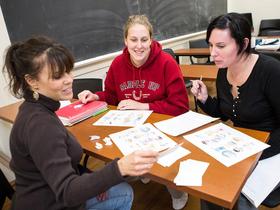Many high school graduates from low-income families head to a two-year community college rather than a four-year school, primarily due to economics. However, a recent study shows that students who are fortunate enough to transfer from a community college to a four-year university often excel with the right encouragement and preparation. The Jack Kent Cooke Foundation released its findings in a report titled, Partnerships that Promote Success: The Evaluation of the Community College Transfer Initiative."
The Jack Kent Cooke Foundation recently hosted a conference in the Washington D.C. area to present their findings and provide the information educators require to help low-income students succeed in their university transfers, according to the foundation website. The conference highlighted the universities involved in the study, along with their community college partners, to show that providing opportunities to high-achieving community college students can be the pathway to greater success for low-income students.
In this video, the Jack Kent Cooke Foundation states that in every state in the nation, low-income students are less likely to reach advanced levels of academic achievement. Students with equal talents but unequal opportunities.
Details of the Study
The Foundation's Community College Transfer Initiative conducted the study by first identifying high-achieving, low-income students in community colleges and then working to improve the transfer process into a four-year institution to maximize their odds of success in their academic endeavors.
In this video, JKCF Scholars and college administrators share their insights and give advice on why and how to transfer from a community college to a selective four-year college or university.
The study worked with eight specific four-year institutions, as well as 60 community colleges that were in a position to partner with them. However, the strategies utilized in the studies could be easily replicated by other four-year universities in the future, according to a report on PR News Wire. The study was conducted over a three-year period.
Study Findings
The study found that during those three years, nearly 2,000 additional low-income students successfully transferred into four-year institutions. These numbers were much higher than the foundation anticipated. Among the students surveyed, nearly 41% were the first in their families to attend a four-year university. Many of those students reported they would not have even considered transferring to a university if they had not received the encouragement of the Community College Transfer Initiative program.
A report in the Chronicle for Higher Education stated that community college transfer students quickly won over the favor of their professors with "intellectual curiosity and appetite for extra work." Emily Froimson, director of higher-education programs at the foundation, told the Chronicle that this study proves that low-income students that transfer from community colleges into highly-selective four-year institutions can be as successful as students who came into the university as freshmen.
"These students could have easily blended in and not made any impact, but they did," Froimson added. "More of these students should be given an opportunity to attend those types of institutions."
Partnerships that Promote Success also showed that students were not the only ones to benefit from the successful transfer process. Universities also gained from the endeavor by receiving students that increased the diversity of the student population, contributed to classrooms in a positive manner, and engaged in campus activities. Schools also benefitted from improved communication and collaboration with one another.
Study’s Purpose
The primary purpose of the foundation's study was to uncover methods that would increase the number of low-income students that transfer to major four-year universities. Nearly $7 million in grants was awarded to the eight universities involved in the study, which included Amherst College, Bucknell University, Cornell University, Mount Holyoke College, University of California at Berkeley, the University of Michigan at Ann Arbor, the University of North Carolina at Chapel Hill, and the University of Southern California.
These specific universities were chosen for the study because they showed a readiness to undertake the program and believed strongly in its potential success. These institutions also modeled missions and values that aligned well with the program itself.
In this video, Cooke Foundation Educational Advisers share tips to help you transfer from community college to a four-year college or university.
While the goal was to increase enrollment of community college transfers by 1,100 low-income students, the final tally of almost 2,000 exceeded the goals and indicated the success of the program. Six of the current institutions would continue with the program to enroll additional community college students each year, but two universities stated they would have to scale back efforts somewhat because of the current recession.
The Jack Kent Cooke Foundation is committed to helping young people reach their full potential through education. The Community College Transfer Initiative was launched in 2005 by the foundation to help students from low-income families successfully make the transfer from two-year community colleges to four-year institutions.
The foundation also offers opportunities to students through their Young Scholars Program, which provides scholarships for both undergraduate and graduate study to low-income, high-achieving students. Grants are also available to non-profit organizations and educational institutions committed to helping low-income students succeed.
Questions? Contact us on Facebook. @communitycollegereview















